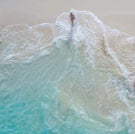Perched among the towering mountain peaks of Isère is the resort of Alpe d’Huez. At 1,860m, it’s the third highest in the French Alps, famous for its family-friendly skiing, stunning views and bountiful alpine hiking trails. But when the snow melts away for summer, the mountain begins to attract a different type of tourist.
From early June to late October, the clatter of ski boots on cobblestone is replaced by clicking of cleats and the whoosh of rubber on hot tarmac, as cyclists flock to the area in their thousands.
Over the years, the winding mountain pass leading up to the resort has served as a backdrop for some of the most memorable moments in pro-cycling history. The late, great Marco Pantani famously completed the 13.8km climb in a still-unbeaten time of 37 minutes back in 1995, and it has featured in the Tour de France no less than 32 times.
To cyclists, it’s a sporting landmark akin to Silverstone or Wembley. The key difference is that anyone can come and pit themselves against the iconic 21 hairpin bends.
And I mean anyone.
Katia Lamb is an Alpe d’Huez local who has been running her bike shop, Cycle Huez, for 14 years with her husband Oli. The couple have watched firsthand as the proliferation of e-bikes has made the mountain more accessible.
“People who might have struggled to get up previously are now able to, thanks to e-bikes,” Katia explains. “Maybe you’re an older cyclist, a partner of a keen cyclist, or just someone who wants to explore the area – hopping on an e-bike will allow you to keep pace and enjoy the sights without the effort.”
Read more on cycling holidays:
The Alpe d’Huez climb starts in the town of Bourg d’Oisans and snakes its way up 3,670ft to the resort. Both areas are home to countless ski shops, many of which turn their focus to bike rentals over the summer months. Katia’s shop provides high-end pedal-powered road bikes for those who want to cycle without the help of a battery, but there are lots of other establishments providing motor-assisted options to suit all body types and budgets.
I’m staying in Alpe d’Huez, so I chose to pick my e-bike up from a shop there. This way, I can zip down to Bourg d’Oisans, enjoy the climb at a leisurely pace and drop the bike back when I’m done – no car required. For those staying in Bourg d’Oisans, the opposite approach makes more sense.
Just getting down the mountain is a feat in itself. It takes roughly 30 minutes going at a modest pace, but gravity does the hard work. All that’s required of me is to feather the brakes as I roll down through the 21 hairpin bends.
After a quick coffee stop in Bourg d’Oisans, I begin the climb. The first section takes me along a straight, flat section of road. It’s easy to be lulled into a false sense of security, but the scale of the challenge becomes apparent as I take a sharp left and the road ramps up like a wall in front of me. Thankfully, I have my rented e-bike, and as I push harder on the pedals, the motor engages and scoots me on my way with little effort required.
Each of the bends on the way up is clearly numbered, from 21 at the bottom to 0 right before the summit. With stops, you can expect it to take roughly two to three hours to get through them all. The first few are steep and long, with little in the way of views due to tree cover. It’s not until I pass through the village of Le Garde-en-Oisans (home to the last café for 8km) that the trees give way to jaw-dropping mountain vistas, complete with colossal rock faces and soaring snow-capped peaks. These scenes only become more impressive as I continue to gain elevation.
The road surface is beautifully smooth as the route winds its way further up the mountain, the distance between bends gradually decreasing as I approach the village of Huez, roughly 5km from the top. Just before the village is bend 7, known affectionately in the cycling world as ‘Dutch Corner’. During the Tour de France, this 90-degree turn plays host to hundreds of famously booze-fuelled and raucous Dutch fans – a tradition stretching back many decades. On a Tour day, the corner turns orange as the spectators flock together in their national colour to cheer, drink beer, set off flares and even rock the occasional police car.
Today, it’s much quieter as I pass by, which is a pity, as by the time you’ve made it to this point, a bit of fervent encouragement probably wouldn’t go amiss.
Huez Village is situated between bends 6 and 4. It’s a great spot to rest tired legs while soaking in the epic mountain scenery. For those in need of a quick refuel, Maison d’Huez offers hot food, drinks and snacks with outdoor seating and spectacular views. But don’t get too comfortable, as there’s still a good chunk of climbing left to go. For those who can’t muster up the requisite strength to get back on the bike, there’s a free gondola that goes from the village directly up to the main resort.
Reenergised, I leave Huez Village and continue up the mountain. Coming around bend 3 the resort of Alpe d’Huez is visible directly ahead for the first time. The prospect of a post-ride beer now in clear focus, I pick up the pace and weave through the final few turns into town.
Alpe d’Huez is split into eight areas. Veil-Alpe is the oldest and most characterful of them all, and it’s the first part of town cyclists enter as they reach the end of the climb. It’s home to a number of bustling cyclist-friendly bars, bike shops and the fantastic La Roy Ladre – a cosy little restaurant serving world-class pizzas and French wines with a smile.
Those who wish to complete the official Tour de France Alpe d’Huez route can follow the markings on the road up to the top of Cognet, the northernmost area of town. Don’t forget to snap a picture at the summit and give yourself a pat on the back before heading back down into town for a well-deserved drink.
Where to stay
The Grandes Rousses Hotel & Spa is the oldest (and most luxurious) hotel in Alpe d’Huez, often hosting World Tour cycling teams during the Tour de France. Perched on the mountainside, it offers stunning panoramic views of the surrounding mountains, a number of fancy restaurants serving local fare, and secure bike storage. You can even book a sports massage in the spa, as I did, to relieve your tired legs.
The hotel is situated centrally within the resort, so it’s conveniently placed for picking a bike up from one of the many local hire shops. I opted for an electric mountain bike from Richard 3 Sports, but there are hybrid and road options available too.
Lyon or Geneva.
There’s also the option to hop on the Eurostar from London to Lille and grab a connection to Chambery. From there it’s roughly a two-hour transfer by car or coach to Alpe d’Huez.
Source: independent.co.uk


